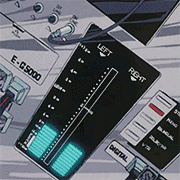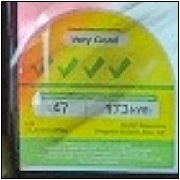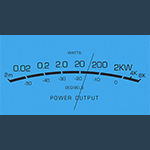|
You know that bullshit audiophile woo-woo "Fidelizer" program that promises to improve sound quality in Windows, but actually does nothing at all to the sound? The guy behind this piece of software junk is active on Head-Fi as "WindowsX", and he's absolutely batshit insane. He starts out right away by completely messing up data compression vs. dynamic compression, and he really gets going on page 2 and soon dives deep into some really amazing bullshit. http://www.head-fi.org/t/631978/320-kbps-mp3-vs-normal-audio-cd-listening-sound-quality WindowsX posted:We once made test comparing between ripped flac and original CD from common laptop using WMP as ripper and player (yeah non-audiophile app) plugged to musiland feeding $100K speakers system with about 10-20 audiophiles (Esoteric K-01/$10k DIY borbely preamp/Karan KA S 450/Rockport Aquila in well treated acoustic large room). The difference between flac and CD is clear like night and day to all 20 audiophiles, let alone mp3 comparing to CD. I hope this tests won't bring another placebo war though. WindowsX posted:I don't think you understand what guy in cnet talks about. Lossless is also compressed and also inferior to uncompressed LPCM. But MP3 is also lossy having some parts of dynamic range cut off like un-needed leftover while some are essentials to reproduce natural harmonics. You won't bother trying to believe in it though so I'll end here. WindowsX posted:For evidences, I forgot most places posted years back. Just feeling nostalogic to make some posts in board I was once addicted during head-fi jorney. Try searching for lossless vs uncompressed and you should find people debating with some links and information. I knew too much to make it simple to understand. There're too many things related to digital domain making atomic clock sounds reasonable in some highend systems. Then he is joined by IanMedium, who clearly has the most golden ears of all. IanMedium posted:I have done extensive listening to 320/ALAC/AIFF/WAV. On poorly produced or already heavily compressed music I hear no difference but on good quality recordings there is even a difference between AIFF and Wav. The tests I have done have been over the past couple of years and that is why I have ended up ripping everything to wav as to my ears there is a difference and it is in feeling and emotion. There are as many details in 320 as in wav but it is not that I am on about and I think there lay the problem with this whole debate. It just goes on and on and on. And this is from the Sound Science forum at Head-Fi, where ABX testing and measurements are encouraged. So while the objective truth and suggestions of ABX testing are forbidden everywhere else, the woo-woo audiophiles are completely free to poo poo all over the one forum where common sense should prevail. What a great way to run a forum 
|
|
|
|

|
| # ? Apr 16, 2024 17:11 |
|
I just listened to some of A Meeting by the River, and it sounds exactly about as interesting as you can imagine. Typical audiophile stuff. To rub it in, I listened to it from YouTube. On my iPhone. Through the mono speaker.
|
|
|
|
KozmoNaut posted:You know that bullshit audiophile woo-woo "Fidelizer" program that promises to improve sound quality in Windows, but actually does nothing at all to the sound?
|
|
|
|
Lol gently caress even going near an audiophile forum.
|
|
|
|
Brocialist posted:Christ I hate that place. Yeah I went there for a while because I thought they knew what they were talking about, but I found out gradually people are just making up all sorts of crazy poo poo.
|
|
|
|
Wasabi the J posted:Yeah I went there for a while because I thought they knew what they were talking about, but I found out gradually people are just making up all sorts of crazy poo poo. People make fun of this forum for being "defend your purchase" but at least not a lot of people here are $10k+ deep on headphone gear that probably doesn't even sound that much different than where they started.
|
|
|
|
quote:but on good quality recordings there is even a difference between AIFF and Wav.
|
|
|
|
To be fair, some valid AIFF and WAV files simply have worse sampling/bit depth. 
|
|
|
|
https://www.youtube.com/watch?v=SzaskxXkWXs E: And here's some audiophile elitist twaddle that isn't a skit from a comedy show: https://www.youtube.com/watch?v=HKDt3JmELAM KozmoNaut fucked around with this message at 14:13 on Feb 6, 2016 |
|
|
|
Didn't even watch beyond the second minute, after he said he's cutting audio from a digital source.
|
|
|
|
Here's another fun one (Google-translated, unfortunately): https://translate.google.com/transl...t-text=&act=url Sure, why not use an opamp with a 2000V/μs slew rate* and a 60MHz bandwidth for a RIAA amplifier? * A slew rate of 5V/μs is more than plenty to handle even the most dynamic signal possible, even if you're crazy enough to use 24/192 for listening.
|
|
|
|
KozmoNaut posted:Here's another fun one (Google-translated, unfortunately): If some is good, more is better. Easy. 
|
|
|
|
quote:Yes, but it's a loving good RIAA. Because listening is the same thing as objectively evaluating component choices. I don't doubt they made it work somehow, but that's in spite of their component choices, not because of them.
|
|
|
|

|
|
|
|
https://www.audiogon.com/listings/full-range-paradigm-studio-100-v2-cherry-finish-2016-01-23-speakers-80020-broomfield-co Someone buy these so I don't and waste a couple of days driving to Colorado and back
|
|
|
|
KozmoNaut posted:Here's another fun one (Google-translated, unfortunately): If you ask me, it's too easy to impress laypersons with amazing sounding numbers that are technically true but ultimately makes no impact in the real world.
|
|
|
|
God drat, thanks for this. I was just thinking about this comic the other day. I vaguely remembered the premise, did a half-hearted google search, and just resigned myself to never finding it. Time to go share it on Facebook and watch all the arguments it will start with all my relatives and friends thinking it supports their particular view. (you realize the guys on those forums think you're the one with your finger in your ears, right  ) )
|
|
|
|
flosofl posted:(you realize the guys on those forums think you're the one with your finger in your ears, right Literally, in this case. One of them has resorted to sarcastically offering the same advice that I do when people ask questions now. Only he's slightly too convincing to be properly sarcastic, so they think he's being serious. Of course I make sure to quote his posts and enthusiastically agree with him  And the RIAA discussion has basically devolved into "well, have you listened to it?" now. Apparently you cannot have an opinion about a piece of gear without having owned it yourself.
|
|
|
|
So...biwiring. This is a thing? I understand bi-amping, but biwiring seems to me like a bunch of audiophool hooey. Is there really anything to it?
|
|
|
|
It doubles the amount of copper in your speaker wires, and that's about it. It could make a difference if you were using thin speaker wire, but it's better to just buy correctly sized wire in the first place. And passive bi-amping is worthless too, you have to use a crossover before the amps and remove the crossovers from the speakers, for it to have any benefit.
|
|
|
|
KozmoNaut posted:It doubles the amount of copper in your speaker wires, and that's about it. It could make a difference if you were using thin speaker wire, but it's better to just buy correctly sized wire in the first place. thanks  RE biwiring, yeah, that's kinda what I figured, didn't see the benefit of it at all. For the record, I have/had no plans of doing any of it
|
|
|
|
I've owned too many not-High end speakers that are designed for bi wiring over the years. It's annoying when you lose the connectors that let you only wire them like a normal person.
|
|
|
|
Yeah that seems like it could be a pain. Saw a picture of the back of a pair of KEFs and they had a rotating knob to do the job, no external flat metal plates to lose.
|
|
|
|
Richard Vandersteen has some interesting thoughts on bi-wiring:quote:What is bi-wiring and what are the advantages? Now someone who is more electronically savvy than I am could probably pick this apart pretty hard, but Vandersteen has his head screwed on pretty straight. Personally I give his opinion on things like this much more weight than a lot of people. Maybe that makes me the thread's gullible audiophile but I'm OK with that. 
|
|
|
|
Panty Saluter posted:Richard Vandersteen has some interesting thoughts on bi-wiring: I'm not an electrical engineer, but that sounded like it was wandering suspiciously close to Tubroencabulator babble.
|
|
|
|
flosofl posted:I'm not an electrical engineer, but that sounded like it was wandering suspiciously close to Tubroencabulator babble. I know just enough about crossovers to think it sounds at least vaguely plausible. I've had the pleasure of meeting Mr. Vandersteen and if nothing else, I don't think that he does anything just to do it. Not to say that self-persuasion isn't a thing but it's not like he makes more money from you buying twice as much wire. He's generally pretty pragmatic and not a gear snob - if a cheap-ish receiver works well enough for you, it's good enough for his speakers. Just buy his speakers, of course 
|
|
|
|
I can't really bring up enough concentration to make it through that wall of text in one go. Do I understand it right that he pretty much just moves the crossover to a different place?
|
|
|
|
Sounds to me like the internal wiring and crossovers are completely separate inside the speakers. As far as the attenuation of the stopband frequencies on each wire pair that sounds pretty correct to me. I've had only an intro to electronics so don't take my word as gospel. As far as lower frequencies modulating higher ones, that's a pretty well known occurrence. How much difference it makes to your listening experience is another thing, but LFO's are a thing so maybe? Really, I'm not saying Vandersteen is right all of the time but he doesn't strike me as the type to talk out of his rear end either. It's at least worth of consideration, IMO. Does anyone know of some good, not too expensive acoustic treatments? My living room is live as heck (really, I just need something to eat up 1k and up) and unpleasant at more than moderate levels. I already have a curtain, throw rug, and couch and while that's better than nothing, there's just a lot of bare surfaces. I've considered a nice huge black velvet Elvis painting for the rear wall. 
|
|
|
|
Panty Saluter posted:Sounds to me like the internal wiring and crossovers are completely separate inside the speakers. As far as the attenuation of the stopband frequencies on each wire pair that sounds pretty correct to me. I've had only an intro to electronics so don't take my word as gospel. As far as lower frequencies modulating higher ones, that's a pretty well known occurrence. How much difference it makes to your listening experience is another thing, but LFO's are a thing so maybe? So, looking at this picture (for example) of the back of a Wharfedale Jade 3, which has a bridge plate between bi-wire/amp terminals, and reading the manual (http://www.wharfedale.co.uk/files/manual/20131112071411_12.pdf), they make no mention of any change to the crossover when you remove the plates, so this really isn't doing anything useful at all then, right? That is, I don't see how removing the plate can also change the crossover.  
|
|
|
|
Well I can't speak for the differences in crossover design but they're claiming similar effects for intermodulation distortion reduction so at least it's consistent that way. 
|
|
|
|
Here's my problem:quote:The effects of bi-wiring are not subtle. The improvements are large enough that a bi-wire set of moderately priced cable will usually sound better than a single run of more expensive cable. Has there ever been a proper test that showed any "not subtle" differences between moderately priced and more expensive speaker cable?
|
|
|
|
Zorak of Michigan posted:Here's my problem: Doubt it. So the effects of biwiring are greater than 0, QED 
|
|
|
|
"Vandersteen" posted:We modified a speaker's crossovers... And then they heard a difference. Note he doesn't quantify, or even qualify the difference, just that they're "better". If you're going to go to the effort of bi-wiring you may as well biamplify and get the free 3db (http://sound.westhost.com/bi-amp.htm) Panty Saluter posted:Does anyone know of some good, not too expensive acoustic treatments? My living room is live as heck (really, I just need something to eat up 1k and up) and unpleasant at more than moderate levels. I already have a curtain, throw rug, and couch and while that's better than nothing, there's just a lot of bare surfaces. I've considered a nice huge black velvet Elvis painting for the rear wall. Velvet tigers are better for low end growl but a velvet Elvis will give improved presleyence. Start with Ethan Winer's primer: http://ethanwiner.com/acoustics.html This is also good reading: http://arqen.com/acoustics-101/room-setup-acoustic-treatment/ Like anything in hifi, the science is pretty sorted but people refuse to hear it. Look into articles that are aimed towards pro-audio/sound reinforcement audiences as people tend to get things right when hundreds of thousands or even millions of dollars are on the line. Small room stuff is a little different, but there's heaps of information on setting up studios that is applicable. Edit: from my understanding, different thicknesses of dampening material (open cell foam, rigid fibreglass/rockwool insulation) will absorb different frequencies of sound. Thicker materials will absorb lower frequencies. Use diffusion or absorption to kill first reflections. Basically, play with your room until you like how it sounds. Diffusers can even look pretty cool: 
A Lone Girl Flier fucked around with this message at 07:16 on Feb 10, 2016 |
|
|
|
Zorak of Michigan posted:Has there ever been a proper test that showed any "not subtle" differences between moderately priced and more expensive speaker cable? Haha yep, here ya go: http://www.audioholics.com/gadget-reviews/speaker-cable-face-off-1/speaker-cable-face-off-1-page-2
|
|
|
|
Panty Saluter posted:Richard Vandersteen has some interesting thoughts on bi-wiring: Croc Monster posted:So, looking at this picture (for example) of the back of a Wharfedale Jade 3, which has a bridge plate between bi-wire/amp terminals, and reading the manual (http://www.wharfedale.co.uk/files/manual/20131112071411_12.pdf), they make no mention of any change to the crossover when you remove the plates, so this really isn't doing anything useful at all then, right? That is, I don't see how removing the plate can also change the crossover. Panty Saluter posted:Sounds to me like the internal wiring and crossovers are completely separate inside the speakers. As far as the attenuation of the stopband frequencies on each wire pair that sounds pretty correct to me. I've had only an intro to electronics so don't take my word as gospel. As far as lower frequencies modulating higher ones, that's a pretty well known occurrence. How much difference it makes to your listening experience is another thing, but LFO's are a thing so maybe? I think we need to get some basic facts about passive crossovers straightened out  Vandersteen claims they separated the high and low frequency parts of the crossover, but that's how all crossovers are constructed, the only difference between a speaker with single terminals or double terminals is whether this split happens on the crossover board itself or at the terminals, electrically it makes no difference. For instance, a two-way crossover actually contains a lowpass filter for the woofer and a highpass filter for the tweeter, and both of these filters operate completely independently of each other. Boiled down to basics, the way the amplifier/speaker interaction works is that the amplifier puts a certain voltage across the speaker terminals. The speaker then "pulls" a certain amount of current according to its impedance. Lower impedance means more current and consequently a higher impedance means less current. And of course voltage times current equals power. A lowpass or highpass filter presents an increasingly higher impedance through the transition band (the frequency range where the rolloff happens), and ideally an infinite impedance above/below that, so no current will be pulled and hence no power applied to the driver outside of its target frequency range as applied by the filter. So the common claims that each pair carries a different part of the signal are completely laughable. Both cables in a bi-wired connection carry the exact same voltage, the only difference is that you part out the current across two wires and lower the total impedance, which gives exactly the same result as simply using a thicker wire. Passive bi-amping is similarly pointless, because you are still limited by the maximum voltage the smallest amplifier can provide before it starts to clip. The only case where it might have a small benefit is if you're running low-impedance speakers on amps with weak power supplies, since you effectively double the amount of current available. But since the low frequencies require an order of magnitude more power than high frequencies, the difference is so small that it is completely negligible, like >90% of the current will be drawn from the amplifier connected to the low frequency terminals anyway. Buy a single more powerful amp instead. The only bi-anything that makes sense is fully active bi-amping (like in active speakers), where you have an active line level crossover before the power amps, and no passive crossovers between the amps and the speaker drivers. In this type of setup, each amplifier only has to deal with part of the signal, effectively lowering the power each of them has to supply to reach the same combined output level. You also have the drivers and amps connected directly together, which improves the damping factor. I hope that satisfies the bi-curious among you 
KozmoNaut fucked around with this message at 10:36 on Feb 10, 2016 |
|
|
|
Waldo P Barnstormer posted:Diffusers can even look pretty cool:
|
|
|
|
Collateral Damage posted:I love the looks of that but I shudder at the thought of keeping it free from dust.  
|
|
|
|
Actually I was hoping for more specific recommendations, I've read and reread all the basic info on acoustics  As for biwiring - is there any truth to the lower frequencies modulating the higher ones?
|
|
|
|
Panty Saluter posted:As for biwiring - is there any truth to the lower frequencies modulating the higher ones? Short answer: No. Long answer: Maybe, but it's dwarfed by the intermodulation distortion in the electronics, and that's not audible at all unless you have some really lovely gear.
|
|
|
|

|
| # ? Apr 16, 2024 17:11 |
|
Panty Saluter posted:Actually I was hoping for more specific recommendations, I've read and reread all the basic info on acoustics Specific recommendations will be specific to your room so it's kind of hard to say without being in it. You could try calculating axial room modes from the dimensions of the room and adding bass traps at those frequencies IF you feel the bass response is peaky or smeared across an extended period of time / reverberate. Otherwise do absorber or diffuser panels on the roof above your listening position and off to the sides for first reflections as already mentioned. To do better than that if speakers are aimed properly you're going into measurement and real maths plus expensive kit which is often the very definition of diminishing returns - unless you're making fat stacks of cash in a studio for example.
|
|
|






























